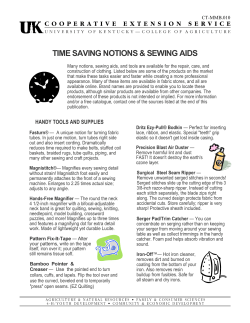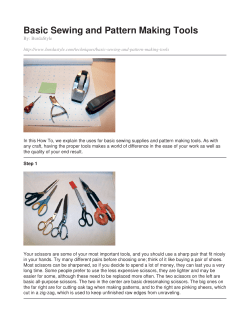
How to Make a Plastic Bag Holder
How to Make a Plastic Bag Holder Seth Custer Paul Gralewski Erica Voss In this project, you will create a plastic bag holder that can be used to store plastic bags you get from the store for later use. You will also learn the basics about sewing, which you can use for future sewing projects. This project takes approximately 1 to 1½ hours to complete. Caution: This project requires a sewing machine and an iron. If you have not used either before or are unsure of how to use them, please ask the 4-H leaders for help. Materials Needed • • • • • • • • • • • • 1 kitchen towel 1 yard of ¼-inch ribbon 2 feet of elastic Scissors Pins Sewing needles Thread that matches the background of your towel Sewing machine Iron Ironing board Ruler Pencil Let the Sewing Begin! Step 1 A) Cut two pieces of elastic a little bit longer than half of the width of the towel. Width—the shorter side of the towel B) Test to make sure you can stretch the elastic along the width of the towel. If it is too hard to get it to both ends of the towel, then cut a longer piece of elastic. Note: Buy a little more elastic than you need—working with elastic is a bit tricky and you may need to experiment with the measurements. Step 2 A) Open towel to the wrong side. Wrong side—the side of the towel that will be on the inside Step 3 A) Use a pencil to make a straight line across both ends of the towel. Note: If you choose a plaid pattern, as shown in the example, you can use the print as a line. Step 4 A) Take the pieces of elastic you cut and mark where the center of the elastic is. B) Now pin the elastic to the towel to help keep the elastic in a straight line when sewing it using the sewing machine. a. Pin one end of the elastic on top of the line you just drew. Make sure the end of the elastic goes about ½ inch past the edge of the towel. b. Pin the middle of the elastic (your mark) to the middle of the towel (as shown in the second image on the left). c. Finally, pin the last edge of the elastic to the other edge of the towel. Remember to pin it so ½ inch of the elastic hangs off the edge. Note: Feel free to fold the towel a bit to make the pinning process easier. C) At the points you have pinned the elastic down, baste the elastic to the towel to hold it in place. Baste—to sew with long loose stitches in order to hold something in place temporarily Note: Make sure you stretch the elastic before basting each section to ensure that the elastic and the towel are in the correct places to be sewn together. Note: You may want to use bright thread to help you see where to sew. D) Use the sewing machine to stitch the elastic onto the towel. a. First start by backstitching the elastic on to ensure the elastic is in place. b. Next stretch the elastic from the edge to the center of the towel and zigzag from the edge to the center point. c. Stretch elastic from the center to the edge and complete the rest of the zigzag stitching. d. Secure the final end with a backstitch. Backstitch—stitching forward and backward for several stitches to secure the thread so it doesn’t pull out. E) Repeat this entire step on the other end of the towel. Step 5 A) Right sides together, fold the towel lengthwise so both selvages are together. Pin in place. Baste seam together if needed. Selvage—the finished edges of a piece of fabric that do not ravel B) Machine stitch a ½-inch seam from one end of the towel to the other end. Backstitch at the beginning and end of seam. C) Press the newly created seam flat. D) Turn the newly formed tube inside out so that the right side is showing. E) Press the seam on the right side. Press—using an iron with stream just gently lift the iron up and down on the fabric, not side to side. Step 6 A) Cut 8 inches of ribbon and make a loop by folding it in half. a. Stitch it in place at the center of the seam about ½–1 inch from the top edge. b. Machine stitch the loop in place by sewing over it several times to hold it in place. c. Clip the extra thread. B) With the rest of your ribbon tie a bow. This bow can then be attached for decoration to the front of your tube. Step 7 The holder is now finished! Stuff plastic bags in the top and pull them from the bottom when you need them. This new plastic bag holder is handy in any kitchen and makes a great gift too! This new plastic bag holder will be a great addition to any household kitchen! Glossary Width—the shorter side of the towel Right Side—side where the image is the clearest Wrong Side—opposite of the right side of the towel Basting—to sew with long loose stitches in order to hold something in place temporarily Backstitching—stitch that is sewn one stitch length backward on the front side (right side) and two stitch lengths forward on the reverse side (wrong side) to form a solid line of stitching on both sides Press—using an iron with stream, gently lift the iron up and down on the fabric rather than sliding the iron back and forth on the material Selvage—the finished edges of a piece of fabric that do not ravel College of Agricultural Sciences Cooperative Extension Prepared under the supervision of Jan Scholl, associate professor of agricultural and extension education. Visit Penn State’s College of Agricultural Sciences on the Web: www.cas.psu.edu Penn State College of Agricultural Sciences research, extension, and resident education programs are funded in part by Pennsylvania counties, the Commonwealth of Pennsylvania, and the U.S. Department of Agriculture. Where trade names appear, no discrimination is intended, and no endorsement by Penn State Cooperative Extension is implied. This publication is available in alternative media on request. The Pennsylvania State University is committed to the policy that all persons shall have equal access to programs, facilities, admission, and employment without regard to personal characteristics not related to ability, performance, or qualifications as determined by University policy or by state or federal authorities. It is the policy of the University to maintain an academic and work environment free of discrimination, including harassment. The Pennsylvania State University prohibits discrimination and harassment against any person because of age, ancestry, color, disability or handicap, national origin, race, religious creed, sex, sexual orientation, or veteran status. Discrimination or harassment against faculty, staff, or students will not be tolerated at The Pennsylvania State University. Direct all inquiries regarding the nondiscrimination policy to the Affirmative Action Director, The Pennsylvania State University, 328 Boucke Building, University Park, PA 16802-5901, Tel 814-865-4700/V, 814-863-1150/TTY. © The Pennsylvania State University 2004
© Copyright 2025












